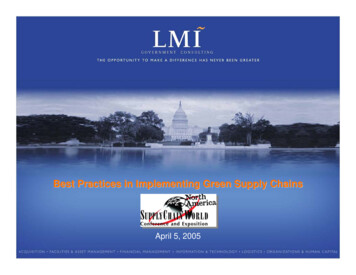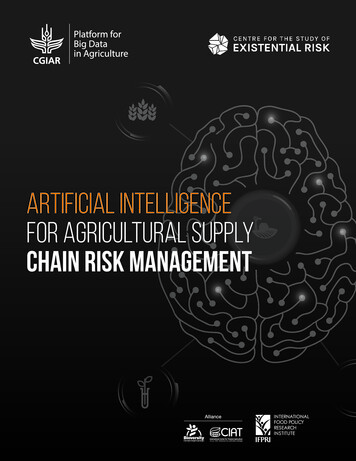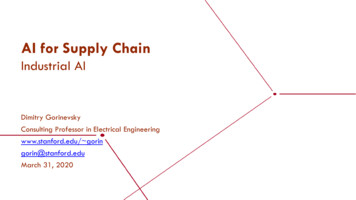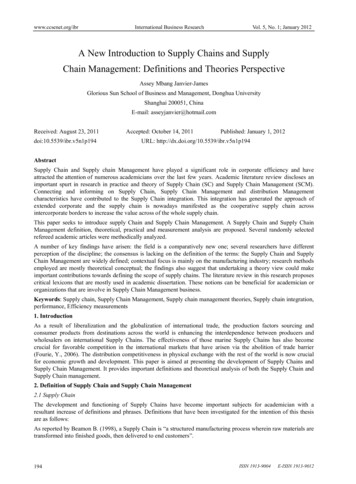
Transcription
GREENING THESUPPLY CHAININEMERGING MARKETSSOME LESSONS FROM THE FIELDBy Terry F. YosiePresident & CEOWorld EnvironmentCenterGreenBiz Reports
Greening the Supply Chain in Emerging Markets:Some Lessons From the FieldByTerry F. YosieNovember 2008Dr. Yosie is President & CEO of the World Environment Center, a global non‐profit, non‐advocacyorganization whose mission is to advance sustainable development in the business strategies andoperations of global companies.1
Not including the recent crisis in credit and lending practices in financial markets, global investment indeveloping and transitional economies rose to 379 billion—the highest level ever—according to the2006 report on foreign direct investment by the United Nations Conference on Trade and Development.Such large investments of capital, and the greater distribution of wealth creation opportunities generatedaround the world, are a response to a variety of factors. These include: liberalization of financialmarkets; privatization of state enterprises; outsourcing of product development functions across globalcompanies; lower operating costs in developing nation markets; rising levels of education; theemergence, in selected markets, of a middle class and evolution of a consumer culture. Parallel to thislarge and growing transfer of wealth and opportunity is the rising level of public concern, among citizensand governments in both developed and developing nations, over natural resource consumption, publichealth and environmental quality and the transparency and effectiveness of decision making by businessand government.Global corporations are at center stage of this debate, in part, because of the growing environmental andsocial footprint of their supply chains in emerging markets. Whereas the supply chain components ofsuch companies (e.g., raw material extraction, factories, storage facilities, distribution systems, retailstores, waste disposal and recycling units) are subject to extensive regulation in most developed nations,such requirements are far less developed and applied in major emerging markets. Nor is the infrastructureof scientific and technical talent, institutional development or consistent enforcement of regulations asevolved in such markets. As a result, global companies face increasing scrutiny and pressure to narrowthe gap in the governance and performance of their operations, and that of their suppliers, across theglobal marketplace.One of the lesser understood factors in the governance of global companies, especially with respect tomanagement of their supply chains, is the limited number of their own employees that are located on-theground in developing market nations. Greening the Supply Chain (GSC) initiatives have emerged as onemeans to compensate for this limitation; they also aim to assist companies to achieve greater economicefficiencies and alignment of sustainability objectives across their operations while working withhundreds and, at times, thousands of independent supplier firms with differing objectives and capabilities.This paper examines the definition and scope of Greening the Supply Chain initiatives, discusses thevalue they contribute to business, identifies selected key factors to success, presents an approach formanaging successful GSC projects and reviews what remains to be done through business management,government policy making and financial management partnerships.Definition and Scope of “Greening the Supply Chain” InitiativesThe term “Greening the Supply Chain” has emerged to describe a wide variety of actions that a growingnumber of companies (chiefly western companies) are presently conducting to install greater performancerigor and operational control over their extended supply chains. Greening the Supply Chain initiatives arepart of a process for implementing a sustainable development plan aimed at achieving improvedenvironmental, health and safety performance; increasing efficiencies in the use of energy, water or othernatural resources or raw materials; reducing the environmental and societal impact of business operationsupon local communities and the global biosphere; and expanding economic and quality of life enhancingopportunities that result from the company’s business activities.2
In this paper, the term “Greening the Supply Chain” refers to the following elements of a company’sinteractions with its suppliers: Applying common environmental and related standards and programs across the parent companyand its suppliers, taking into consideration local legal frameworks and cultural characteristics. Extending management system implementation to ensure greater accountability of supplierperformance on health, environment, safety, resource consumption and social factors. Examining opportunities for business process redesign or innovation, materials substitution orproduct design. Adopting specific performance goals and metrics to evaluate the performance of specificsuppliers over time. Practicing greater transparency in reporting performance results. Developing partnerships with government agencies, non-government organizations and otherinstitutions to improve specific aspects of performance beyond a company’s specific capabilitiesor to leverage access to technical, managerial or financial resources.Corporations must also improve their performance in a range of other measures including the employmentof children, human rights, wage rates and anti-corruption initiatives, to name a few. While equallyimportant to the above factors, they are not specifically addressed within the scope of this paper.To maximize their effectiveness for the global company, Greening the Supply Chain initiatives should notexist separate from the mainstream activities of the business. Rather, they should be fully integrated withand reflect the core value proposition of the business strategy. They should yield measurable results thatare part of an integrated business-sustainability plan. Business managers should directly participate intheir design and implementation.Over the past four years, the World Environment Center (WEC) has implemented eight GSC projects in avariety of geographic regions. WEC is an independent non-profit, non-advocacy organization whosemission is to advance the implementation of sustainable development in the business strategies andoperations of global companies in partnership with national governments, multi-lateral institutions, nongovernmental organizations and other stakeholders. WEC has undertaken projects in collaboration withthe following organizations: 2004 project with fifteen suppliers of Alcoa in Mexico (funded by the U.S. Agency forInternational Development). 2004-2005 project with The Dow Chemical Company in Sao Paulo, Brazil with twelve suppliers(AID funding). 2004-2006 Johnson & Johnson project with six Tier 1 suppliers in Mexico and eight suppliers inBrazil (AID funding).3
2006-2007 project in Romania with Alcoa Fujikura, a joint venture of Alcoa and Fujikura Ltd(funded by AID). 2006-2008 projects with fifteen suppliers to the beverage, food and hotel business sectors in ElSalvador (AID funding). 2006-2007 project with eight suppliers to the General Motors Corporation in the Shanghai, Chinaregion (funding provided by General Motors). 2008 project with forty suppliers to Shanghai General Motors (SGM), a joint venture of GeneralMotors and the Shanghai Automotive International Corporation (funding provided by SGM). 2008 project with fifteen suppliers to GM Holden in the Melbourne, Australia region (funded bythe Australian Ministry of Innovation, Industry, Science and Research).The focus of these initiatives was to reduce raw material use, conserve natural resources, advance energyefficiency, implement cleaner production techniques, improve recycling and reduce emissions to protectpublic health and environmental quality.Business Value of GSC InitiativesWhat is the business value that results from seeking to achieve a greener supply chain? Based on WEC’sexperience with the above referenced projects, the sources of business value include the following (seeFigure 1):Figure 1: Business Value of Greening the Supply Chain Initiatives Mitigating business risks Reducing costs Motivating better performing suppliers Preserving business continuity Enhancing market access and degrees of business strategy freedom Mitigating risks to the business. The incentive to implement GSC initiatives occurs at a time ofrising awareness and concern among developing country policy makers and citizens to reduceenvironmental contamination; stakeholder, business peer and marketplace pressures to adoptformal sustainable development policies; evolving legal requirements; and a growing expectationfor improved corporate governance of supplier performance. Reducing risks to the business fromcurrent environmental, health and safety factors, or responding to expectations of future controlson carbon emissions or other substances can both advance company-supplier learning andincrease the operational integrity of business processes across the supply chain to create businessvalue.4
Reducing costs. At a time of rising costs from energy consumption and other resource and rawmaterial inputs, global companies have more direct incentives to improve the efficiencies of avariety of operating processes. These range from research and development priorities; buildingdesign and maintenance; manufacturing process design and operations; heating, ventilation andair conditioning systems; refrigeration; storage facilities; vehicle fleet maintenance andpurchasing; procurement; materials and product distribution; and materials re-cycling and re-use.High cost structures are frequently embedded in each of these functions many of which resultfrom continuing reliance upon previous generation technologies or operating standards andpractices that result in higher than necessary consumption of energy, water and other inputs. Motivating better performing suppliers. The nature of supply chain management processes inglobal companies creates both growing economies of scale in the marketplace and increasedinterdependencies and complexity in product development and distribution. Such characteristicscan also yield higher levels of vulnerability to the corporate customer if suppliers do not achieveexpected levels of performance. Given the increasingly complex and extended supply chains ofglobal companies—and the well documented performance shortcomings of suppliers in a varietyof business sectors—the implementation of sustainability initiatives creates an opportunity tofurther focus and rationalize supply chains by eliminating low performers and focusing on afewer number of suppliers that can meet more rigorous sustainability performance criteria whilemeeting the needs of the marketplace. Alternatively, GSC projects create the opportunity forcustomers to further stabilize and advance business relationships with their suppliers through asustained, mutually advantageous, partnership. Preserving business continuity. Business operations in emerging markets frequently experiencedisruption from the interruption of electricity supplies or other energy or natural resource inputsnecessary to production. The current year in China has witnessed power shortages in thealuminum industry as well as rotating blackouts in other manufacturing sectors as the governmentattempts to allocate scare energy supplies in the wake of growing industrial and consumerdemand. Green supply chain initiatives that focus on energy efficiency and other aspects ofsustainability can buffer business processes from such disruption while contributing to emissionreductions. Enhancing market access and strategic degrees of freedom. Whether in emerging or developedmarkets, global companies seek to maximize the degree of freedom they possess to produceproducts in a market-based system. In some sectors, however, the need for business access to anatural resource competes with society’s growing need for the same resource. Nowhere is thiscompetition more direct than in the growing demand for water resources or for food supplyingredients that are also valuable for producing transportation fuels. Companies seeking tomanage their demand for such resources while reconciling the needs of civil society will obtaingreater long-term control over their business strategy by combining business process innovationwith solutions to societal problems. For example, The Coca-Cola Company has established acorporate goal of becoming “water neutral” by replenishing the amount of water used inproducing a variety of its beverage products, thereby reducing the competition for access to ascarce resource and avoiding the attainment of its business goals in competition with those ofconsumers. Companies that do not reconcile their business strategy with societal objectives5
increase the risk that they will become the focus of increasing societal conflict and politicalaction. This outcome will reduce the ultimate control of their business strategy and result in thesignificant diversion of management time and other resources.Some Key Factors to SuccessThe World Environment Center’s implementation of Greening Supply Chain initiatives in variousregions of the world has, to-date, yielded the identification of six key factors for success. They arepresented in Figure 2 and include:Figure 2: Some Key Factors to Success in Greening the Supply Chain Initiatives Obtaining senior management commitment Providing direct, on-the-ground support to suppliers Acknowledging the wide range of supplier competencies Creating benefits for suppliers Recognizing external incentives for greener supplier performance Working within the national culture with local people Obtaining senior management commitment from both customer and supplier companies.The absence of such commitment at the very beginning of GSC projects will obscureagreement on their goals and value, add unnecessary complexity to decision making,diminish the willingness by mid-level managers to commit staff time and other resources, andminimize the opportunities for value creation through information-sharing, innovation andlearning. Providing direct, on-the-ground capabilities to work with suppliers—including training,technical support, mentoring, monitoring and performance assessment. GSC initiativescannot be managed from either global or in-country headquarters. Web-based training andother technological alternatives provide a timely and useful capability for working withsuppliers but face-to-face interactions, preferably in supplier locations, are a critical elementto gain support and trust from supplier company managers to ensure success. Acknowledging the wide range of supplier competencies. Suppliers to global companiesexist in a variety of sizes and levels of sophistication. Many suppliers are “mom and pop”operations, while others are large and sophisticated global product and service providers. Asuccessful GSC planning process will recognize the range of capabilities that exist along thesupplier continuum and tailor specific projects to upgrading the talents and systems necessaryto achieving project goals.6
Demonstrating the economic value to suppliers. Obtaining value from GSC projects is not aone-way street. There must be a clear and compelling case that benefits will accrue tosupplier firms. Such benefits can take a variety of forms, including: strengthenedcompetitiveness, improved manufacturing processes, cost reductions, improved productivityand closer business relationships with customers. Value creation, rather than “passing theaudit,” should be the primary motivation for both company and supplier participation in GSCprojects. As many suppliers are themselves firms with increasing market presence that maywork for a variety of global customers, their bargaining power with customers combined withtheir own quest for value should be explicitly recognized in efforts to green the supply chain. Recognizing external incentives for greener supplier performance. In many developingnations there is a relative absence of such external incentives such as effective governmentregulation and enforcement, stakeholder pressures for improved supplier performance orgreater transparency and governance of supplier operations. In such instances, globalcompanies should support steps to build competent government and non-governmentalsustainability institutions; and increase the infrastructure of scientific, technical andmanagerial talent required to develop and implement effective regulations; and constructpartnerships talent across business, government and non-governmental organizations toachieve common objectives. Absent business leadership and participation in such endeavors,the default assumption of many corporate stakeholders will be that the pursuit of marketbased business strategies will occur at the expense of the broader interests of society. Working within the national/regional culture with local people. Given the relatively limitednumber of in-country sustainability professionals who are permanent employees of globalcompanies, the use of local partners becomes a necessary virtue. Operating andcommunicating within an accepted cultural context with host country citizens can furtherenhance the legitimacy of GSC projects even while taking advantage of expertise fromindigenous regions.Management Approach for Greening the Supply ChainThe Key Factors to Success must be integrated with a rigorous process aimed at creating business valueconsistent with the corporation’s sustainability objectives. WEC’s management approach for its Greeningthe Supply Chain program continues to evolve based on the experience built through the eight previouslyidentified projects. At present, this approach consists of an eleven step process (also depicted in Figure3):Figure 3: Steps in Managing Greening the Supply Chain Initiatives Obtaining written customer selection of supplier participation Organizing senior leadership involvement in project inauguration Forming a supplier core staff team Preparing an initial supplier self-assessment7
Developing key project goals and scope Conducting site visits and training Planning a mid-term assessment/making necessary adjustments Finalizing the project with documentation of results Providing customer feedback Learning and celebrating success Tracking future progress Obtaining a written customer invitation for supplier participation in GSC projects. Once thecustomer selects the suppliers it wants to participate in a GSC project, it is important tocommunicate in writing the purpose, goals, expected value and timetable of this effort. Theacceptance by suppliers represents an important statement of their acceptance of accountability toachieve project goals. Both customer and supplier statements should have senior levelmanagement endorsement and support. Organizing a kick-off event with senior customer and supplier management followed by initialtraining of supplier staff professionals. The kick-off event is used to obtain senior leadershiparticulation and commitment to the GSC project’s goals, reinforce these goals to participatingstaff and aid in establishing the personal relationships that will need to be sustained by thoseresponsible for direct implementation of project tasks. Discussion of the details of a projecttimeline is also included in this step as is baseline training of staff to promote a commonfoundation of learning. Forming a supplier core staff team. Each supplier is charged with the responsibility ofidentifying those staff accountable for improving their organization’s performance throughout theproject’s cycle. This would include agreement on reporting relationships, frequency ofinformation sharing and the desired levels of staff competencies. Preparing an initial self assessment of supplier capabilities, needs and current performance. Aself assessment template is distributed to enable supplier staff to develop a realistic profile of thecurrent level of knowledge, skill sets, adequacy (or existence) of management systems and otherbarometers necessary to establishing an accurate baseline of capabilities and performance todetermine subsequent actions. Developing key project goals and areas of focus. As previously mentioned, each supplier has itsown capabilities and limitations depending on the size and sophistication of its organization andwork history. A GSC project should aim to improve a supplier’s performance in key areas, butthese may differ for each firm. This phase of project management accounts for such variabilityby providing flexibility and encouraging customer-supplier dialogue to choose the specific areas8
of focus (e.g., energy efficiency, water conservation, environmental emissions) and the numericalgoals to guide supplier planning and participation. Conducting site visits and Web-based training. Following the creation of a supplier core staffteam and the completion of the initial self-assessment, more focused training is applied. Theform of such training will be influenced by the selection of project goals and the number ofparticipating suppliers. If the number is relatively small ( 50), individual on-site training ispossible (depending on the geographic distribution of the supplier firms). If the number is larger,more reliance on Web-based training is recommended in order to effectively manage projectcosts. Dedicated Web sites can also be designed to foster information exchange and dialogueamong supplier and customer staff and WEC experts. An iterative learning process is thusestablished to provide responses to questions, case examples and templates to guide supplier teamdecision making. Planning a mid-term assessment. WEC conducts continuous on-line tracking of each supplier’sprogress throughout the length of the GSC project and prepares periodic assessments for thecustomer. By the mid-term of the project’s timeline, each supplier is directed to prepare anassessment of its progress against its original goals and areas of focus. Such an assessment canlead to adjustments such as additional targeted training in problem areas or refinement of goals.In addition to the mid-term assessment, suppliers participate in a workshop to share perspectivesand areas of learning. Finalizing the project. As suppliers complete their individual project tasks they are asked todocument their results based on the original goals and scope they defined; the measures they haveimplemented to achieve these outcomes; the investment/costs of such results; and otherinvestments they could make if financing was available. Such documentation is essential inpreparing for the final project audit whose conclusions and recommendations will be included ina final report to the customer. Providing customer feedback. Following its review of the final supplier report, the customer willassess whether the results achieved match its expectations of value for the GSC project. It canrecommend further areas for supplier improvement in the future. This feedback process alsoplays a role in determining whether the customer wishes to maintain a business relationship withan individual supplier. Learning and celebrating success. A final workshop is organized to enable the customer and itssuppliers to assess their respective learning, highlight successful results and share innovativeprocesses or initiatives they developed. Senior executives and core staff teams of customer andsupplier firms participate in this final event. Tracking future progress. As part of a process for ensuring continuous improvement, thecustomer will periodically survey those suppliers with which it maintains an on-going businessrelationship. This can also include access to Web-based training and other information resourcesto enhance skills and upgrade practices.9
Who manages the GSC projects and how are they funded? Throughout the processes discussed in thispaper, the World Environment Center has served as the project manager and was responsible fororganizing the various activities described. WEC maintains an on-the-ground cadre of experts in variousdisciplines who work directly with customer and supplier firms. These experts are drawn from localconsulting firms, universities, retired government or industry employees or other in-country WEC partnerorganizations. WEC appoints a senior level Technical Director for each project whose role is to supportand advise the customer, while ensuring the effective organization and implementation of projectmilestones and deliverables from suppliers. Given the limited number of customer company staff, WECstaff and experts serve as a GSC “bridge” among the participating organizations, organize technicalsupport and periodically highlight opportunities for the customer to communicate with individualsuppliers to ensure that sufficient progress is achieved.GSC projects are funded through a variety of mechanisms. As a non-profit, non-advocacy organization,WEC has received funds from government agencies to conduct “capacity building” projects to assistsmall and medium sized enterprises that are suppliers to global corporations. WEC member companiesalso provide resources for specific GSC initiatives.Some Unfinished BusinessGSC projects, if effectively designed and managed, can yield important benefits to corporations andsociety by advancing the integration of sustainable development across the business value chain. Suchprojects should not be viewed as one-off experiments but, rather, as part of a continuous process of onthe-ground learning and adaptation as companies, suppliers and their stakeholders commit to channelingthe dynamic and disruptive qualities of the global marketplace through processes that further legitimizeeconomic activities in ways that more directly benefit themselves and civil society.This paper has summarized the value, lessons and processes of some selected GSC initiatives conductedby the World Environment Center during the 2004-2008 period. However, just as a major corporationcannot fully control the myriad of challenging economic, environmental and social problems around theworld, neither can Greening the Supply Chain projects address all of the varied problems encountered bybusinesses and their suppliers.Several additional steps can further complement the role and value of GSC activities. They include: Changing the culture of business decision making to acknowledge that returns onsustainability-related projects represent legitimate forms of investment. At present, too manybusiness managers and external financial analysts regard returns on capital from sustainabilityinvestments as “less real,” as if cost reductions from energy efficiency improvements or use ofalternative materials in product development were less subject to calculations of value.Frequently, in the ever-intense competition for capital within corporations, business projects thatdon’t account for life cycle impacts continue to find favor over those than reduce theirenvironmental and societal footprint. Integrating sustainability goals and processes more directly into procurement decisions. Whilethe number of companies with green purchasing policies continues to grow, the rate of progress isslow and uneven across business sectors and even within individual companies. Although the10
efforts of corporate sustainability staff are admirable, procurement managers and departmentsshould become the real owners of this process by establishing sustainability goals and timetablesto drive their decision making. Building institutional knowledge and capacity among government agencies to advancesustainable development. In many national markets both public policies and governmentagencies are insufficiently developed to drive sustainability performance across small andmedium sized enterprises as well as some larger firms. The lack of such a “policy floor” createsadded limitations for GSC projects given that many suppliers do not possess or maintain effectivemanagement practices as part of their operations. More robust regulatory and enforcementprograms would create a necessary complement to the actions of global companies to implementsustainability with their suppliers as well as create a more level playing field across thecompetitive landscape. Financing supply chain improvements to advance sustainable development. GSC projectsidentify a number of recommendations for technology investments or the upgrading of otherpractices to improve supplier performance. Depending on capital needs and payback times,individual suppliers can sometimes finance these improvements. Frequently, however, it isunrealistic to expect that either supplier firms or their global customers alone can provide thefinancing for many of these improvements. Partnerships involving global companies, their smalland medium-sized suppliers and multi-lateral financial organizations can provide anotheralternative to identify, finance and implement specific actions to implement sustainabledevelopment and would represent a natural follow through from greening the supply chainprojects.SummaryContinued deterioration of public health and environmental conditions in developing nations, growingpublic awareness of sustainability challenges, and increasing stakeholder expectations relating to thegovernance and transparency of global corporations in their supply chain operations will exert addedpressure to green the supply chain. To increase the prospects for success, GSC initiatives should reflectthe implementation of a company sustainability plan that is integrated with a company’s business strategyand operations. GSC projects should be measured by business indicators of success, such as costreduction, risk mitigation or greater operational reliability, in addition to environmental and energyperformance indicators.This paper has synthesized the results of a smal
managing successful GSC projects and reviews what remains to be done through business management, government policy making and financial management partnerships. Definition and Scope of "Greening the Supply Chain" Initiatives The term "Greening the Supply Chain" has emerged to describe a wide variety of actions that a growing










